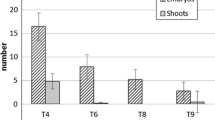Abstract
The micropropagation of T. garganica, a medicinally important plant, was investigated as an option for conservation purposes as wild populations are becoming sparse. A Murashige and Skoog agar medium supplemented with 0.5 mg l−1 α-naphthaleneacetic acid and 1.5 mg l−1 benzyl-6-adenine significantly improved the production of multiple shoots directly from petiole and leaflet explants compared to other plant growth regulator (PGR) combinations. Medium free of PGRs promoted rooting at a low incidence. Acclimatisation was low—52% plantlet survival—as micropropagated plantlets were highly susceptible to fungal rot once removed from culture. Application of antifungal agents to in vitro-derived plantlets as pre- and post-acclimatisation treatments during transplanting significantly reduced ex vitro mortality.

Similar content being viewed by others
Abbreviations
- ANOVA :
-
Analysis of variance
- BA :
-
Benzyl-6-adenine
- IBA :
-
Indole-3-butyric acid
- NAA :
-
α-Naphthaleneacetic acid
- PGR :
-
Plant growth regulator
References
Avato P, Cornett C, Andersen A, Smitt UW, Christensen SB (1993) Localization of the acyl groups in proazulene guaianolides from Thapsia transtagana and Thapsia garganica. J Nat Prod 56:411–415
Chand S, Sahrawat AK, Prakash DVSSR (1997) In vitro culture of Pimpinella anisum L. (anise). J Plant Biochem Biotech 6:91–95
Christensen SB, Andersen A, Smitt UW (1997) Sesquiterpene lactones from Thapsia species and medicinal chemistry of thapsigargins. In: Krogsgaard-Larsen P, Christensen SB, Kofod H (eds) Progress in the chemistry of organic natural products. Munksgaard, Copenhagen, pp 243–252
Debergh P, Maene LJ (1981) A scheme for the commercial propagation of ornamental plants by tissue. Sci Hortic 14:335–345
Dodds JH, Roberts LW (1985) Experiments in plant tissue culture, 2nd edn. Cambridge University Press, Cambridge
Drew RKL, Brocklehurst PA (1984) The effect of sodium hypochlorite on germination of lettuce seed at high temperature. J Exp Bot 35:975–985
Drew RKL, Brocklehurst PA (1987) The effect of sodium hypochlorite on thermo-inhibition of lettuce seed. Acta Hortic 215:179–184
Ekiert H (2000) Medicinal plant biotechnology: the Apiaceae family as an example of development. Pharmazie 55:561–567
Furuya Y, Lundmo P, Short AD, Gill DL, Isaacs JT (1994) The role of calcium, pH, and cell proliferation in the programmed (apoptotic) death of androgen-independent prostatic cancer cells induced by thapsigargin. Cancer Res 54:6167–6175
George EF (1993) Plant propagation by tissue culture (part 1) The technology, 2nd edn. Cambridge University Press, Cambridge
George EF, Sherrington PD (1984) Plant propagation by tissue culture: handbook and directory of commercial laboratories. Exegetics, Bassingstokes, pp 71–83
Hakii H, Fujiki H, Suganuma M, Nakayasu M, Tahira T, Sugimura T, Scheuer PJ, Christensen SB (1986) Thapsigargin, a histamine secretagogue, is a non-12-O-tetradecanoylphorbol-13-acetate (TPA) type tumour promoter in two stage carcinogenesis. J Cancer Res Clin Oncol 111:177–181
Hansen G, Wright SM (1999) Recent advances in the transformation of plants. Trends Plant Sci 4:226–230
Hewitt EJ (1966) Sand and water culture methods used in the study of plant nutrition, 2nd edn. Commonwealth Agricultural Bureaux, Farnham, UK
Heywood VH (1971) Biology and chemistry of the Umbelliferae. Academic Press, London
Jäger AK, Schottländer B, Smitt UW, Nyman U (1993) Somatic embryogenesis in cell cultures of Thapsia garganica: correlation between the state of differentiation and the content of thapsigargins. Plant Cell Reps 12:517–520
Jakobsen CM, Denmeade SR, Isaacs JT, Gady A, Olsen CE, Christensen SB (2001) Design, synthesis, and pharmacological evaluation of thapsigargin analogues for targeting apoptosis to prostatic cancer cells. J Med Chem 44:4696–4703
Kowalski B, Jäger AK, van Staden J (1999) The effect of a seaweed concentrate on the in vitro growth and acclimatization of potato plantlets. Potato Res 42:131–139
Murashige T, Skoog F (1962) A revised medium for rapid growth and bioassays with tobacco tissue cultures. Physiol Plant 15:473–497
Rasmussen SK, Avato P (1998) Characterization of chromosomes and genome organization of Thapsia garganica L by localizations of ribosomal-RNA genes using fluorescent in-situ hybridization. Hereditas 129:231–239
Rasmussen U, Christensen SB, Sandberg F (1981) Phytochemistry of the genus Thapsia. Plant Med 43:336–341
Rayns FW (1993) Micropropagation. In vitro cultivation of plant cells. Biotechnology by open learning. Butterworth-Heinemann, Oxford
Smitt UW, Jäger AK, Adsersen A, Gudiksen L (1995) Comparative studies in phytochemistry and fruit anatomy of Thapsia garganica and T. transtagana, Apiaceae (Umbelliferae). Bot J Linn Soc 117:281–292
Thastrup O, Cullen PJ, Drøbak BJ, Hanley MR, Dawson AP (1990) Thapsigargin, a tumor promoter, discharges intracellular Ca2+ stores by specific inhibition of the endoplasmic reticulum Ca2+-ATPase. Proc Natl Acad Sci USA 87:2466–2470
Tutin TG, Heywood VH, Burges NA, Moore DM, Valentine DH, Walters SM, Webb DA (1968) Flora Europaea, vol 2. University Press, Cambridge
Xiaohui SL, Denmeade SR, Cisek L, Isaacs JT (1997) Mechanism and role of growth arrest in programmed (apoptic) death of prostrate cancer cells induced by thapsigargin. Prostate 23:201–207
Acknowledgements
The fruits of T. garganica were kindly collected and donated by Prof. N. Villalobos, University of Salamanca (Spain). The Natal University Research Fund and the National Research Foundation (South Africa) are thanked for financial support. Mrs. L. van Staden is thanked for assisting with the acclimatisation of the plantlets.
Author information
Authors and Affiliations
Corresponding author
Additional information
Communicated by P. Debergh
Rights and permissions
About this article
Cite this article
Makunga, N.P., Jäger, A.K. & van Staden, J. Micropropagation of Thapsia garganica—a medicinal plant. Plant Cell Rep 21, 967–973 (2003). https://doi.org/10.1007/s00299-003-0623-8
Received:
Revised:
Accepted:
Published:
Issue Date:
DOI: https://doi.org/10.1007/s00299-003-0623-8




